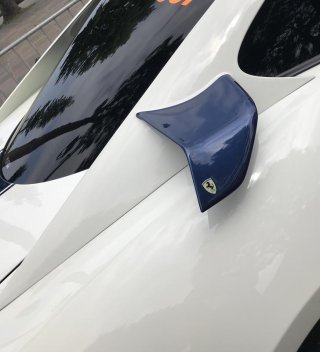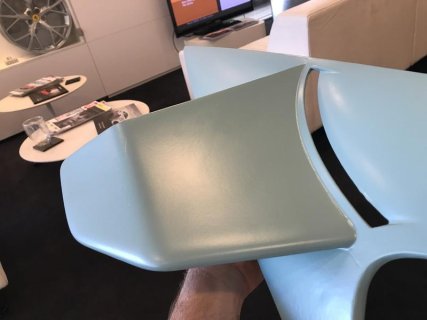darft vader
New member
Nice pics not sure about those new wings tho :hmmm:
Nice pics not sure about those new wings tho :hmmm:
I fist saw them on a 599GTO and don't fancy them much either (looks-wise). If they serve a real purpose however and the car's driven hard, as yours is then yep, a good call. Are they from the XX?Yeah they are quite agressive BUT uncanny in eliminating the problem they were designed to solve.
Five bolts each to remove and return to stock.
Mod, I may have missed an earlier explanation, but what problem are they designed to address and at what speed can you feel the effect?


Thanks, clever stuff. How fast is fast road driving though, what is a medium speed corner and how fast would you need to go to get wheel spin on exit? Are we talking like 100 mph i.e. approx half the top speed or is that too simplistic? Assume this helps with things such as your MM exploits?
Hope these aren't stupid questions.
The guys at the factory told me that meaningful downforce with winglets starts earlier than standard at 100km/h and peaks at EDIT 224 km/h EDIT where the car needs no further rear axle downforce. I questioned why the 599 XX EVO has a massive wing but they showed me it is actually active and therefore controls both front and rear downforce fore and aft. The winglets on my car along with its standard nolder and GTO diffuser produces a theoretical peak just shy of 300kg of downforce.
What this translates to is meaningful inprovement in the shift from second to third which is where the car strips it’s rear tyres of rubber at an alarming rate but more importantly triggers the electronics which means you end up driving around them and not using everything the power train can give. Of course we are talking small margins in a specific window but as an engineer that sort of stuff appeals to me.
Did the factory say what contribution to the downforce the winglets provided. Quite interesting and I might just get my old naca books out and see if I can figure it out. (Serious test of the grey matter!)
The end plates are interesting as well as they look far bigger than you would need, so either they are that way for style or something else is happening there.
Cheers for posting up.
Did the factory say what contribution to the downforce the winglets provided. Quite interesting and I might just get my old naca books out and see if I can figure it out. (Serious test of the grey matter!)
The end plates are interesting as well as they look far bigger than you would need, so either they are that way for style or something else is happening there.
Cheers for posting up.
I’d rather you break out a software package as we have learned a great deal since the days of the NACA books.
Think of the wing fences as the equivalent of your holiday airliner ones BUT upside down - then consider the length of the wing - very short and the top surface of the rear panel being a hard surface vs. The sky in the airliner example. Hence the proportion of fence required to produce the same holding effect. It’s likely that these winglets produce very little to the overall downforce figure but are very specific to the problem they are seeking to solve which won’t take that much to solve but to do it with little drag is the cool aspect for me. Note the bleed slot will at high speed improve the original downforce effect from the buttress / nolder combination by providing an upper holding layer of pressure over the boot. That these winglets therefore do two different things at different speeds is what I like about them more than the aesthetic...
I cant imagine that the winglets provide much of that downforce. I conclude this from conducting very unscientific studies whilst flying, and sticking my hands out into the airflow. :laugh:
I assume you stuck your hand out of the upper part of that lifting body so you will have been playing in low pressure. Modern cars don’t lift and indeed many create downforce so have their high pressure on the upper surface. Putting you hands into the airflow on an aircraft vs a car understandably leads to very different feelings.
Also if we are to have any discussions on modern aerodynamics let’s get a few of the myths out of the way.
1) How wings actually work - 95% of people are taught the wrong science that is out of date.
https://www.cam.ac.uk/research/news/how-wings-really-work
That video is very misleading as the wing is approaching a stalled condition and in normal level flight the wing profile will be flatter. Also I cant agree with his assumption that most people have the wrong idea. All the pilots I know understand how a plane fliesYou could also put several aerodynamics experts in the same room and they will all have slightly different ideas, but the normal consensus is the leading edge of an aerofoil will produce some downforce and the trailing edge will produce lift - thats why the thickest part of the wing is always in the front quarter or third of the wing, leaving the trailing edge area much bigger than the leading edge. However its all a bit of a dark art as a flat plank of wood will generate lift given sufficient angle of attack and airspeed.
Take a modern 747 at full load - each square foot of wing generates 165 Lbs of lift at take off speed - equate that to a Pitts Special stunt plane and it suggests it would only need 9.8 square feet of wing area to get off the ground but the actual wing area is 125 square feet. I put this as a toung in cheek question to two aerodynamicists and thats when they start to argue

I'd say (I'm sure) more than most owners you demonstrate just what a superb car the 599 is :thumbsup:
